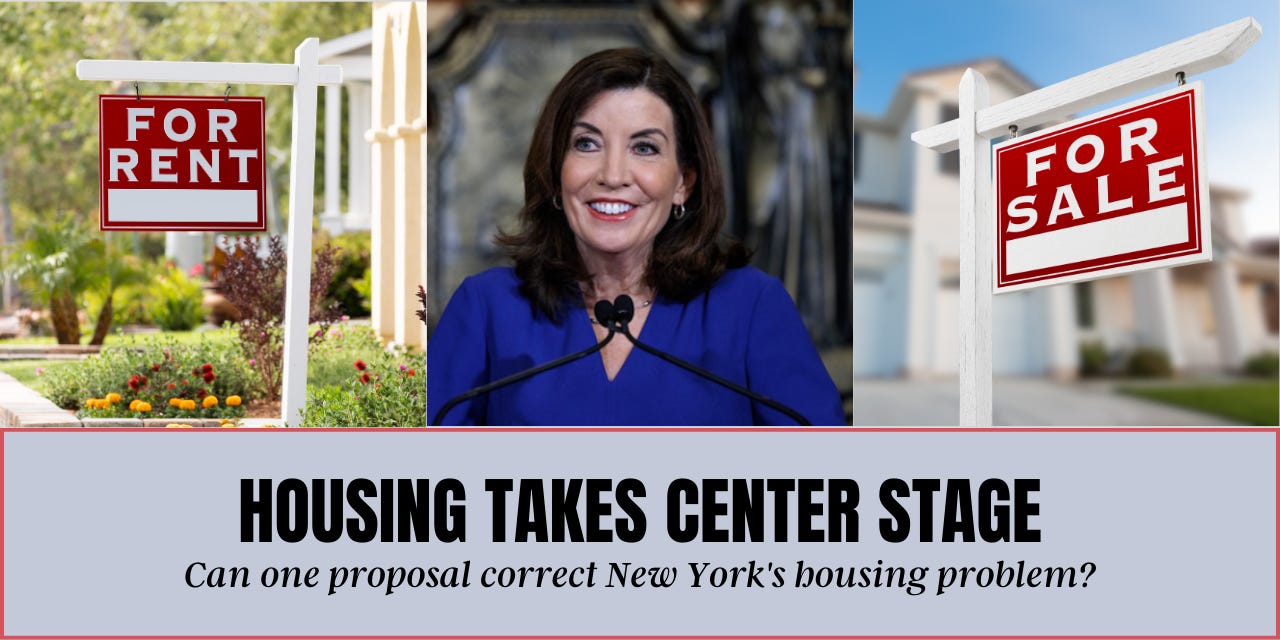This weekly newsletter is going to dive into big issues. We’ll also incorporate some conversations with interesting people along the way! Come along for the ride and welcome to our first edition!
Sign-up to receive it in your inbox every weekend!
THE FACTS
New York has a housing crisis. Those are Governor Kathy Hochul’s own words. To address it she’s proposing a buildout of 800,000 new homes over the next decade “to meet the historic shortage, and support New York renters and homeowners.”
On Wednesday, the Governor will release highly-anticipated details of the plan. Many believe the details will determine how successful the program can be in solving this larger-than-state problem.

FROM HOCHUL’S STATE OF THE STATE
- The New York Housing Compact will require all cities, towns, and villages to achieve new home creation targets on a three-year cycle.
- Under the Compact, localities will decide how to best meet their new home construction targets. Whether repurposing underutilized office parks and strip malls to offering new incentives towards multifamily buildings, localities will be able to choose how to increase housing supply.
- To encourage the inclusion of affordable housing as part of the new growth, affordable units will be assigned extra weight in calculating localities’ progress toward their goals.
HOUSING CRISIS BY THE NUMBERS
- In Upstate New York, rents have risen 40-60% since 2015, while home prices have risen 50-80%.
- Here’s a great county-by-county breakdown of median sale prices between 2019 and 2021 for all of New York.
- According to the Population Reference Bureau, more than half of New York renters are rent-burdened, meaning they pay more than 30% of their income on rent.
BIG QUESTIONS
What is a home?
That sounds like an incredible simple, stupid question. But the answer will address a looming concern in the debate around housing in general. More people have been driven into the rental market because home prices have skyrocketed, corporations have been purchasing single-family homes in bulk, and remote work has made it possible to live away from work. Depending on what the state considers a home — this proposal, if adopted as is, could have an array of outcomes.
RENTING VS. OWNERSHIP
For example, if the state winds up with 700,000 new rental units and 100,000 owned homes; 500,000 new rental units and 300,000 owned homes; or 300,000 new rental units and 500,000 owned homes — those represent three very different outcomes.
The state appears to be operating in ‘unit’ mode, which is to say, they want to solve the problem of getting people housed at a more affordable rate. But the consequence of not emphasizing individual ownership means it could come at the expense of future ownership for many New Yorkers. We’ve seen corporations come in and swallow up swaths of single-family properties and turn them into rental units.
These entities are operating with more capital than ever before, and now the state is going to streamline the zoning process. The terms, conditions, and definitions the state puts on what a ‘home’ is will have serious long-term implications.
Will 800,000 homes be enough?
This past week on WXXI’s Connections with Evan Dawson an expert broke it down like this: In order for New York to reach its housing goal every community would need to increase housing units by 1%. They described it as a very attainable, realistic goal. They even went as far as to say it is possibly how the Governor came to that 800,000 figure.
Describing it that way, though, feels like a lackluster approach to solving something widely accepted to have reached ‘crisis’ level. If it were as simple as every community increasing its available stock by 1% over a period of years — it probably would’ve happened already.
How will this be enforced?
The timeline is really murky. We know the state will be keeping tabs on communities as they go through the process … whatever that might mean. Any municipality that doesn’t do so will face some consequence from the state. The Governor’s original announcement about the Compact hinted that consequences for inaction may not happen for three years. There were several references to three-year cycles in the decade-long initiative. That means we could see an immediate push to get this legislation across the finish line, but no real development in select communities if they so choose.
All told, there’s a lot of unknown — and hopefully in a few days — we’ll have more answers than questions.


